What is wrong with my chicken's beak?
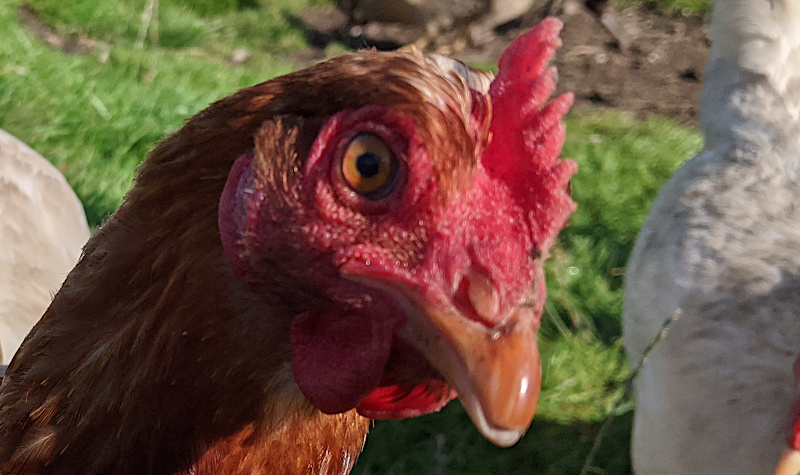
Nearly all beak problems in chickens exist on a sliding scale, minor injuries and deformities will not effect the chickens ability to feed and preen itself but major ones will.
Table of Contents
- List of beak problems in chickens:
- Why is a healthy beak so important for chickens?
- Broken, damaged and injured beaks in chickens:
- Feeding chickens with problematic, scissor or broken beaks:
- Crooked, crossed beaks or scissor beaks.
- Overgrown beaks:
- Debeaking and beak trimming:
- Parrot beak or under-bite in chickens:
- Beak necrosis.
- Canker:
- Oral thrush:
- Chicken beak peeling or flaking:
- Prevention of beak problems in chickens:
Beak problems and deformities occur occasionally in chickens, and can be congenital or acquired. They are caused by a number of different factors, including poor diet, genetics, trauma or injury, disease, tumours and inappropriate incubation practices.
It may be that the damage or deformity is too great for the chicken to survive. Beak damage or deformities can affect how long a chicken will live as it may not be able to eat or care for it's feathers properly.
You must never breed from a chicken with a beak deformity.
List of beak problems in chickens:
Severe beak problems will prevent a chick hatching which is one good reason not to help a chick emerge from the shell.
- Broken, damaged or injured beaks.
- Crooked, crossed beaks or scissor beaks.
- Overgrown beaks.
- Debeaking
- Parrot beak or under-bite in chickens.
- Beak necrosis.
- Canker.
- Chicken beak peeling
Most deformations of the beak are immediately visible after hatching.
Why is a healthy beak so important for chickens?
Chickens need a health and intact beak to be able to feed themselves, drink water and preen their feathers. Cockerels also use their beak for mating and fighting.
Below: A high definition 4 K video of a chickens beak close up.
Chickens use their beaks for:
- Feeding.
- Drinking water.
- Investigating their surroundings.
- Preening their feathers.
- Dust bathing.
- Establishing the social structure and fighting.
- Cockerels use their beaks to grab hens when mating.
Chickens beaks are made from keratin and grow all the time, just like human fingernails. In the course of leading their lives chickens wear down their beaks at the same speed they grow.
Below: This is a healthy and well proportioned beak on one of my white Leghorn cockerels.

Broken, damaged and injured beaks in chickens:
Chickens can break their beaks or more commonly, chip the end off them. If the beak is damaged to the quick and bleeding then the injury will be painful.
A chickens beak can be damaged in an encounter with predators or other animals, I had one that suffered a broken beak after being kicked by a horse. The extent of the injury determines whether the bird will survive but as long as the base of the beak is intact, it will grow back.
Below: This poor chicken lost nearly her entire upper beak in an opossum attack.

The base of the beak is intact and will begin to grow again but it may never be as good as new. Birds with injuries like this will need to be tube fed while the initial injury heals and maybe for quite a while after.
There is no specific treatment for cracked chipped and broken beaks in chickens. A chipped or cracked beak will heal itself over time by growing out. All treatments are supportive.
Please do not try to fix a chickens beak with glue or adhesives.
If your chickens are regularly suffering broken and chipped beaks then you will need to supplement the diet. Keratin production is affected by lack of protein, Vitamins B, C, D and some minerals as well. Make sure you are not feeding too many treats or junk food and that the pellets are fresh.
Below: A chipped beak on a chicken. This will heal in it's own time.
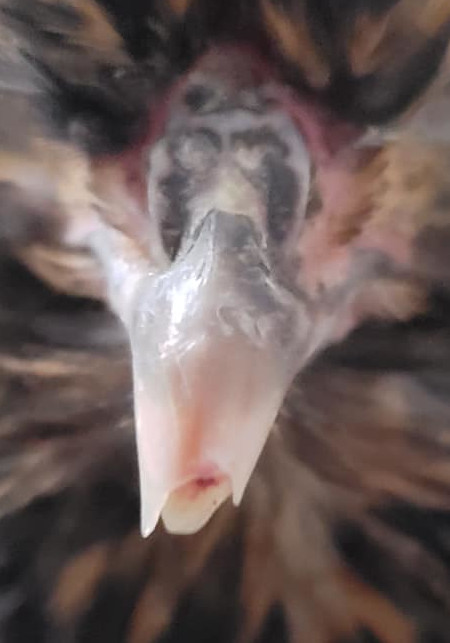
A chicken's beak can bleed as it contains a quick and a blood supply. A chickens beak may start bleeding if the damage is far enough back, just like your fingernail would.
Treating a chipped beak: No treatment is required for minor chipping of the end of the side of the beak. Chipping is common, especially for free range chickens and it is unlikely to effect the way the bird eats or drinks and will heal just fine in it's own time over a few weeks.
Treating a cracked beak: Small cracks can be ignored and large ones need to be watched, otherwise leave the beak grow and the crack will disappear or the tip will fall off when it's ready.
Treating a broken beak: As long as the chicken can eat and drink it should be OK but you will need to separate her until the beak is completely healed as other birds will peck at the blood. You can put some plain white flour on it to stop bleeding.
Below: A chicken with a broken beak. You can see the beak is bleeding because it has broken below the blood supply or quick.
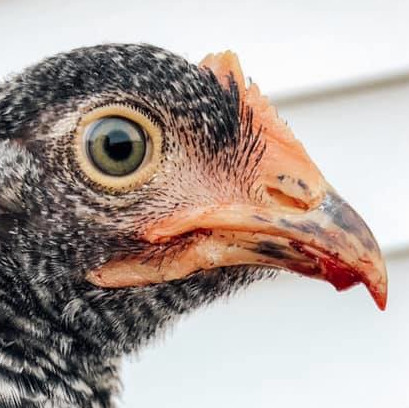
This bird will need to be separated from the flock until the wound heals but after that she will be fine.
A chicken's beak will continue to grow throughout her lifetime, so as long as it is just the tip, her beak should grow back with no problems.
Normally, her beak will slowly wear down with use, but if her beak grows faster than it wears, the tip may break, or a break can be caused by an injury.
Feeding chickens with problematic, scissor or broken beaks:
As you might guess, eating is more difficult for a chicken with crooked, deformed or broken beak and chickens will have a hard time surviving because they won’t be able to get enough food or water, especially if there is lots of competition from other flock members.
When feeding chicks or chickens with damaged or broken beaks you need to add calories, dampen or wet the food and remove whole grains.
Tips for feeding chickens with damaged or deformed beaks:
- Feeding wet and soft but not runny feed.
- Using a deeper dish with steeper sides can help them eat more effectively
- Add calories in the form of shelled sunflower seeds.
- Supplement the diet with seaweed and electrolytes.
- Use a coffee grinder to make food particles smaller.
Comparing chicks with deformed or damaged beaks to the other birds of the same age they will start to fall behind on its growth.
Crooked, crossed beaks or scissor beaks.
One or both halves of the beak of a chicken may be deformed in opposite directions or to the same side.
Scissor beak, or lateral beak deviation, is where the top and bottom halves of the beak grow in opposite directions making it very difficult, if not impossible for chickens to eat, drink and preen their feathers.
It’s not likely that there is anything that can be done for misaligned or scissor beaks in chickens as it is a genetic deformation of the skull or the result of a serious injury.
You can not fix or correct scissor or crossed beaks in chickens, they will have to live with the condition their whole life.
Corrective surgery may be possible but the chicken must still never be used for breeding. Banding has been used to straighten mild case of scissor beak but this may be considered a cruel practise.
Below: A day old chick with a scissor beak.
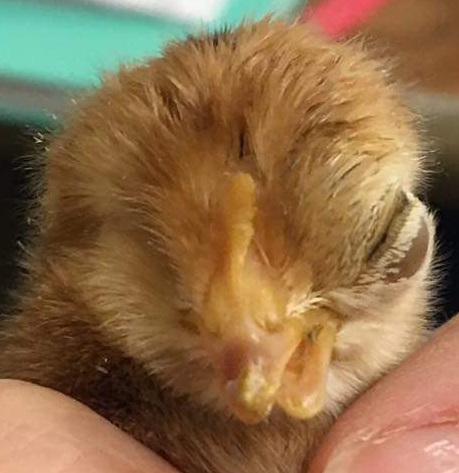
You should avoid clipping, trimming or filing the beak of a chicken with crossed or scissor beak as it only serves to weaken what is left and has little benefit.
Beak deformities occur more often in some breeds like the Ameraucana and are an inherited trait that breeders of chickens should select against.
Below: A relatively severe scissor beak or lateral beak deviation in a young hen.
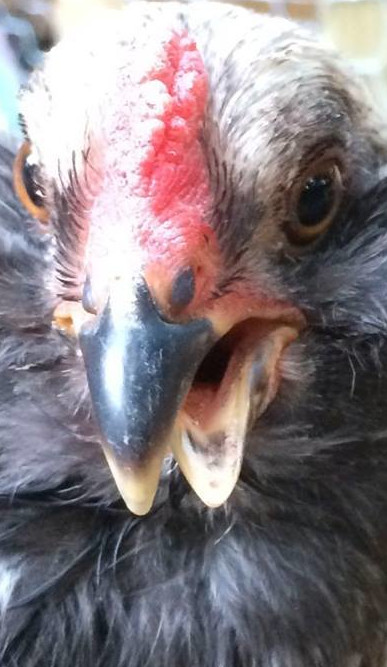
This bird has found ways to deal with it's shortcomings and can eat and drink fine and mostly leads a normal life.
Chickens with scissor beaks do better with a deep bowl of crumble food that has been wet.
Scissor beak can not be fixed. In fact there is nothing wrong with the beak. The problem is with the skull being misaligned, that is why it can not be fixed. Do not allow a scissor beak chicken to reproduce as it is a genetic defect.
A slight deformity of the beak will likely not even be noticed and some chickens learn to shovel their food. Scissor beak is a condition where the upper and lower portions of a chicken’s beak grow in different directions and can become more severe as the bird grows.
Below: A bad lower beak deviation. This bird will struggle to feed and drink.
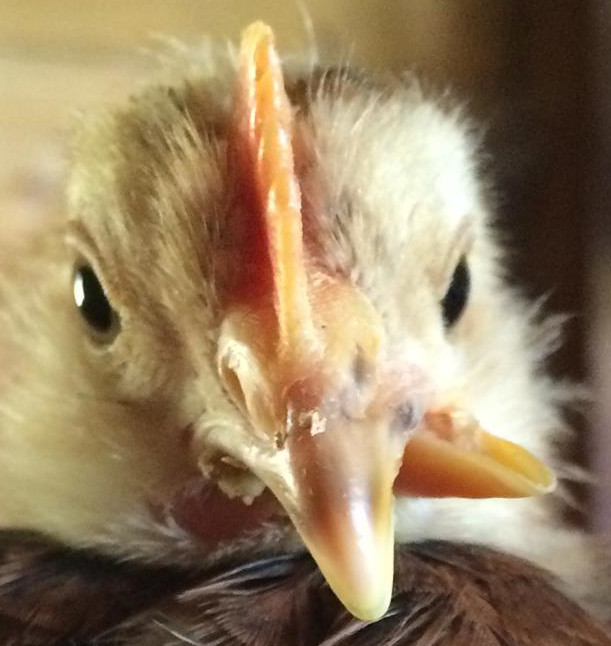
This deformity can make normal eating and drinking very difficult for the bird so you will keep a close eye on them and change things so the bird can eat, drink and try to live a normal life.
Overgrown beaks:
A chickens beak grows while the bird is alive and it can get too long and over grown.
An overgrown upper beak can interfere with eating, drinking and preening of feathers.
Normally chickens wear down their beak but confined chickens and birds with deformities can get overgrown beaks.
Below: A chickens with a seriously over-gown beak. Overgrowth like this is best treated in stages by trimming and filing.
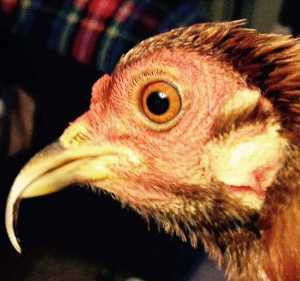
Treating chickens with overgrown beaks:
Treating overgrown beaks is done by carefully trimming and filing the beak in stages till the desired shape and size is obtained. Beak trimming is a two person job.
Trimming a chickens beak is done in exactly the same way you do your nails and if you make a mistake and cut too deep then cussing and bad tempers will follow.
Trimming is done with a pair of nail clippers for the small beak cutting jobs or a pair of cutters for the bigger ones.
Below: An Orpington with the beginnings of an over grown beak. This sort of overgrowth is best treated with a few short strokes from a nail file every week until corrected.
Debeaking and beak trimming:
Debeaking, also called beak conditioning in the industry is the practice of trimming the tip off the beak of day old chicks destined to be layers.
Beak trimming in this manner started in the 1940's when a farmer realised that chickens that had had the end third of their upper beak removed could not indulge in feather pecking and cannibalism.
Below: A chick being debeaked by the hot wire method.

Between one and two thirds of the top beak are removed and one quarter of the bottom beak.
Beak trimming is painful and can affect the long term behaviour of the chickens.
Below: The end result of beak trimming on a battery hen. This chicken has had half of the top beak and one third of the bottom beak removed.
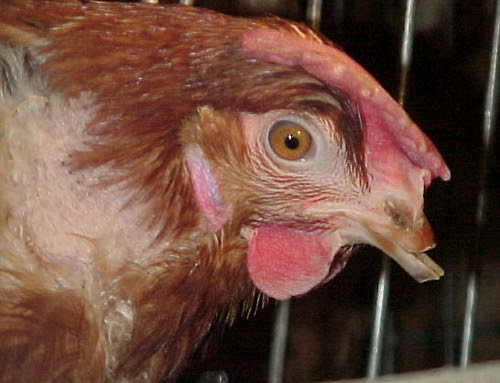
Debeaking in this manner is not practised by backyard chicken keepers and is not normally necessary in the home environment.
This practice has been largely discontinued in the UK as there is little evidence for it's effectiveness and most chickens here are free range and free range birds should not have their beaks trimmed.
Parrot beak or under-bite in chickens:
Parrot beak, or mandibular prognathism, is when the bottom half of the chicken's beak is too short, or the top half has grown excessively long. The top beak then grows downward in a curved fashion and looks just like a parrots beak.
There is no treatment for parrot beak other than regular trimming to keep the halves of the beak in as good an alignment as possible.
In some cases both the upper and lower half of the beak can grow in a stunted fashion resulting in a chicken with a short beak.
Beak necrosis.
Beak necrosis is a type of beak rot that comes from feeding poultry too much wet or finely ground mash feed.
The wet feed accumulates in the edges of the beak and mouth and leads to necrosis and ulceration.
You can avoid beak necrosis by using a large feed size.
Treatment is topical and symptomatic and mostly not required beyond a change in feed.
Canker:
Canker, oral canker or avian trichomonosis is an infectious disease of birds caused by the flagellate protozoan parasite Trichomonas gallinae. It is found the world over and is usually caught from wild birds. Canker cause yellow cheese like growth in the beaks or upper intestinal tracts of birds.
The most common method of transmission of oral canker in chickens is sharing drinking water with wild birds, especially pigeons.
Younger birds are more susceptible to canker.
Below: A bad case of canker in a chicken.
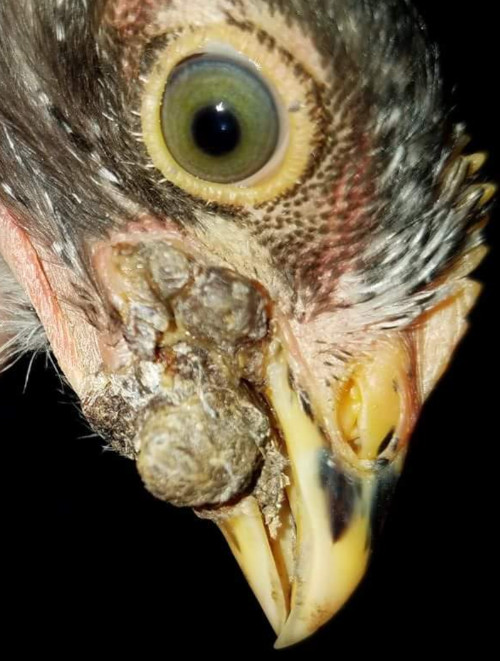
Canker causes lesions to grow inside the beak, esophagus, and crop which are yellow in colour and sticky. The condition can be fatal if left untreated.
Below: Canker inside the mouth in chickens.
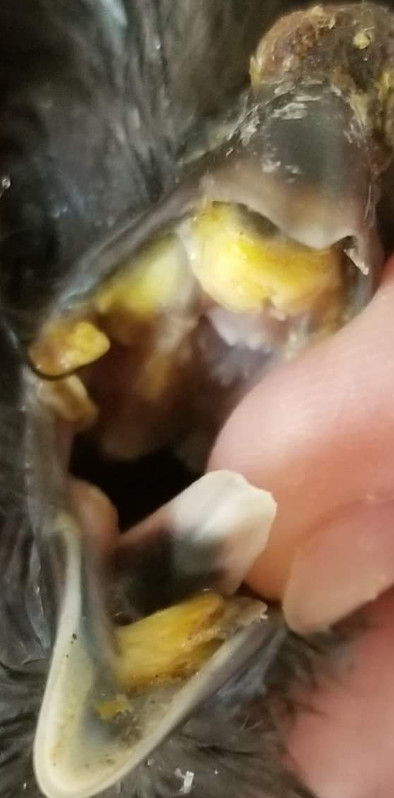
The growth begin to interfere with eating, drinking and eventually breathing if left untreated.
The treatment for Canker in chickens is Metronidazole and thyme extract and taking measures to prevent mixing with wild birds.
Oral thrush:
Oral thrush is a a yeast or candida infection in the mouth of chickens and can effect the oral cavity, oesophagus and crop.
Raised white patches appear on the surface of the tissues inside the beak.
The treatment for oral thrush in chickens is the anti-fungal medication Nystatin and copper sulphate.
Chicken beak peeling or flaking:
This is when the outer protective layer appears to peel of the tip of the beak leaving a ridge. It is normally the result of a chicken scratching the surface of the beak on something sharp like the edge of a metal container.
A peeling beak is normally nothing to worry about unless your birds are malnourished in some way.
The resulting lines on the beak will smooth out over time especially if your chickens free range but if you are worries or their is a big ridge you can smooth the edge down with a nail file.
Prevention of beak problems in chickens:
Prevention of beak problems in chickens starts with regular visual checks on the flock.
- Provide some rough stones or rocks as chickens will rub their beaks on them.
- Ensure chickens have the correct diet.
- Free range chickens have less beak problems.
- Select parents carefully.
- Use good incubation practices.
- Don't breed out of season.
- Don't help chicks to hatch.
